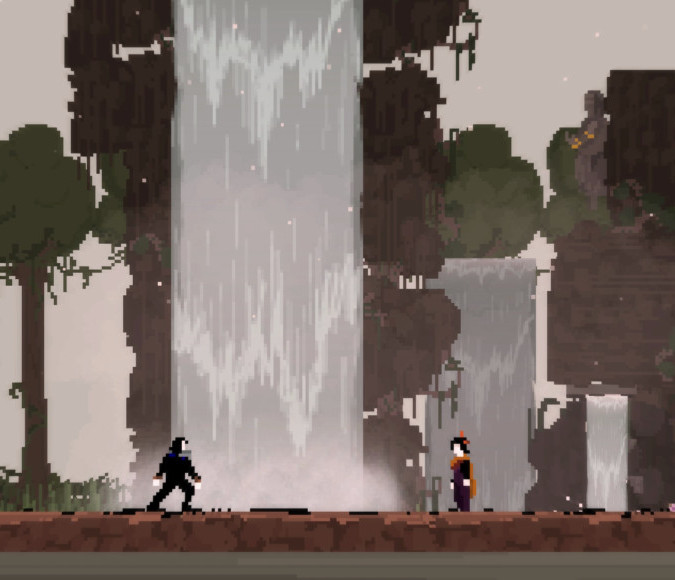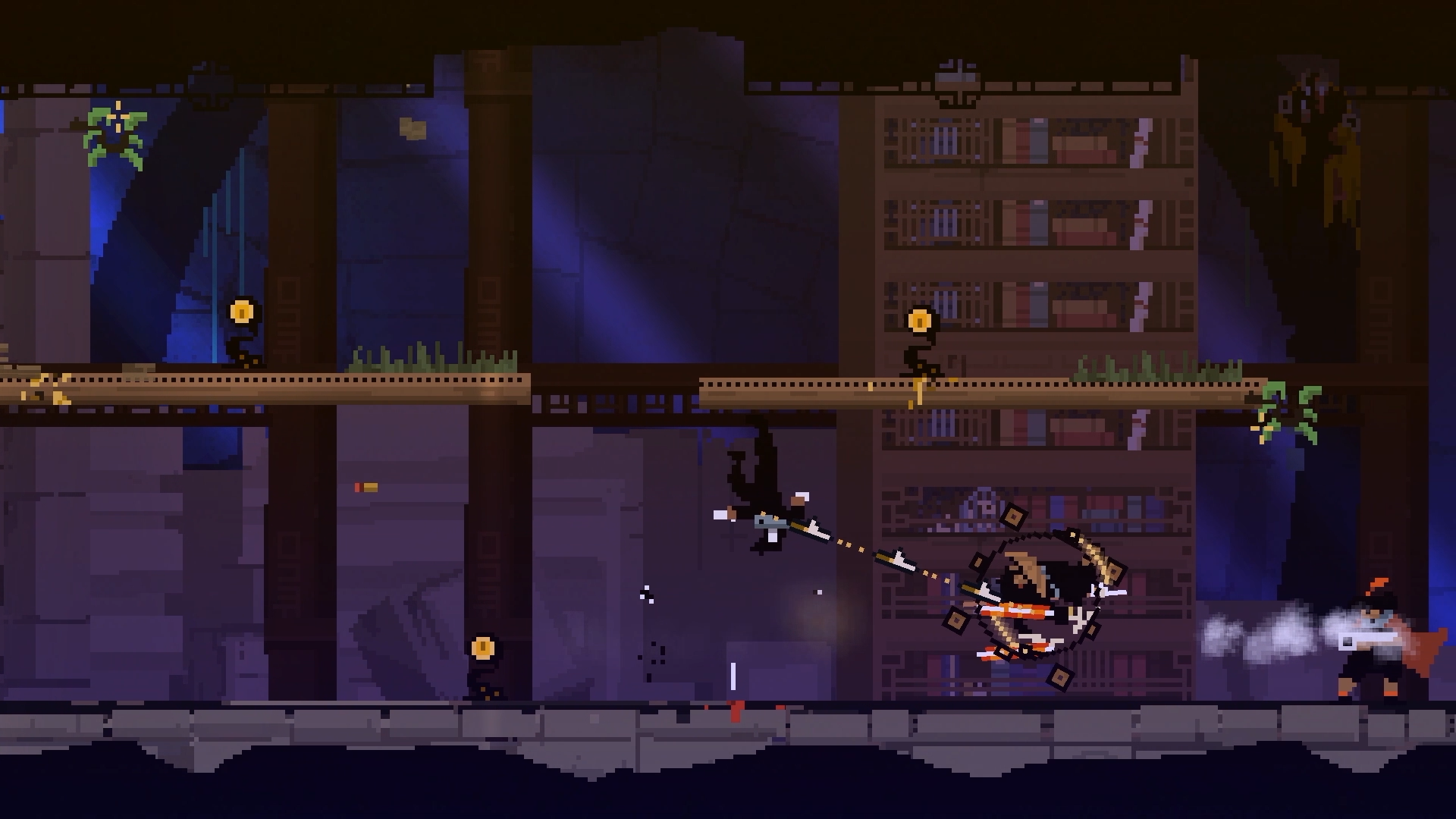Platforms:
Xbox One, PS4, PC,
Released:
January 29, 2021
Publisher:
Devolver Digital
Developer:
Skeleton Crew Studio
When I first saw Olija being advertised, the thing that really struck me was the gameplay. The character fluidly teleporting around the battlefield and carving pixelated chunks of flesh from their opponents. I knew nothing of the context for what was happening. I didn’t really care. It looked hectic, vicious and all kinds of enticing. In practice, all these attributes lie at the core of Olija. There’s just a lot of wasted time that surrounds it.
The Journey of Lord Faraday
Faraday, Olija’s protagonist is an… interesting one. The story, as I can decipher, follows Faraday’s failed quest to find riches to bring back to his slowly crumbling coastal town. Along the way he finds a cursed artifact know as “The Harpoon”. With a new weapon in hand, he takes to lost temples and towns and seeks riches within, as well as building a new settlement.
Olija, and the world the game has created, has a layer of mythology to it. On the one hand, this is a nice touch. I always love games that tell big stories. I like that there is a big world, a world with elements beyond ourselves. The feeling of being a cog in a machine can be a powerful one that forces a reflection of the consequences of our actions. But on the other hand, stories still need to be about the individuals that inhabit them. Unfortunately, Faraday feels more like a role than a character. His lack of personality and characterisation I suppose is expected because Faraday is a mute protagonist. This means that the game gives no clear emotional cues, and instead relies on long-shot moments with no dialogue.
Mythology, pixels and a lack of communication

One big problem in the story and the game is a lack of communication. In the case of the plot, the mythological feeling of everything leads to things being a bit miasmic. One level is stealth-only, for should this faction see you, they will kill you on sight. Although the next time we see that faction, they’re handing over a priceless artifact to you. Did I just miss the part where peace was brokered? Was that one time that person looked at me a sign that peace was just a thing now? I’m all for slathering narratives in metaphor and telling a wordless story, but when these kinds of basic questions are still on the table, something has gone amiss.
A related issue is Olija’s pixel art style. I, like many other indie fans, love a pixel retro style. However, when you’re trying to follow a plot with no dialogue, removing my ability to read facial expressions is not appreciated. Once again, this reduces your ability to read the room and decipher more abstract elements. Shifts in music and intentional cutscene-like seizing of control are really the only ways the game can command you to pay attention. That’s not to say these are always failures. A scene where you pick a flower for another character springs to mind. It’s a nice little gesture. However, earlier sequences are rather ambiguous as to the intention of this relationship. Is this a gesture of thanks or of love? Granted, not all of these ambiguities are deal breakers in the information department.
The Core Loop: Where Olija shines
Before we get too deep into the other issues in-game, let’s talk about the core gameplay. I must commend the developers here. Simply put, when it’s good, it’s good. Early in the campaign you receive “The Harpoon”, a cursed item that allows you to teleport to any object or enemy hit. It’s by no means a new mechanic, but it adds some traversal to the combat that really helps open things up. There’s an exciting freneticism to the experience, whether it be a precision platforming section, puzzle focused, or jumping from enemy to enemy in a combat sequence.
Close combat, conversely, is less satisfying. It tends to quickly devolve into button mashing and it can be hard to decipher what’s going on. The pixel art style does not help. The player character is a bunch of pixels with a lot of black in the colour palette. The enemies are also pixels with black in the colour palette. Crowd a bunch of enemies together and it becomes difficult to parse what is happening. The combat does get better once the harpoon is unlocked, however.
I’d also be doing the game a disservice if I didn’t mention the boss fights. There isn’t a ton, and I would have liked more, but all these encounters bring some unique spice into the gameplay. I think these fights are approachable enough for newcomers, but still require a lot of attention and precision as you get down towards the end of the campaign.

Hard Seas to Navigate
Systems in Olija can feel a little underexplained. The tutorial in this game is minimalistic. There are also definitely a few puzzles that introduce new mechanics without any real fanfare. What seems to be obvious traps, for example, might be necessary to jump into to progress. The other, more frustrating problem is that it is far too easy to get lost playing this game.
The game lets you sail to different levels by checking a map. This map, accessible only when sailing to a new level, also contains all the information about key items. There is a lot the game assumes of the player. There are two types of gates dotted around the map and two types of keys to open them. Easy enough trial and error perhaps. However, when Olija opens up, one of the gates is accessible. A gate that, it turns out, cannot be opened until the campaign’s end. Yet, there I was jumping up and down trying to open the door to no avail. There’s a real sense in this game that a lot of the answers can be stumbled upon. But in doing so, having a smooth ride at the start of the game becomes more of a “probable” result than is reasonable. Made worse, this is the start of the game, we don’t really know what to expect, short of a proper tutorial into the world.
Olija’s lack of information, in retrospect
It’s important though to remember that issues created by a lack of information are invariably going to be less of a problem going forward. Combat being too close together is remedied somewhat with the traversal of the Harpoon. Confusing scenes make more sense when surrounded by enough context. Information is learned through repetition, despite my desire to learn through instruction. I won’t explicitly give Olija a free ride for any ambiguity, but it undeniably gets better over time.
6
Decent
Positive:
- Traversal adds a lot to puzzle and precision platforming, and to combat
- The boss fights are well executed
- Combat is hectic and punchy
Negative:
- Story is too vague
- Gameplay information isn't very accessible
- Pixel art style can obscure information
I want to like Olija much more than I do. When the game works it truly works. The gameplay is slick and brutal and fluid. I will never deny the enjoyment that this game provides. The problem is quite simple, which is that there are only so many fresh, exciting encounters the game can give you. They are a finite supply. However, the time wasted through unclear instruction and a lack of accessibility to information is unforgivable. Perhaps other players will find the ambiguity to be less of a problem, but for me it was a real obstacle.





